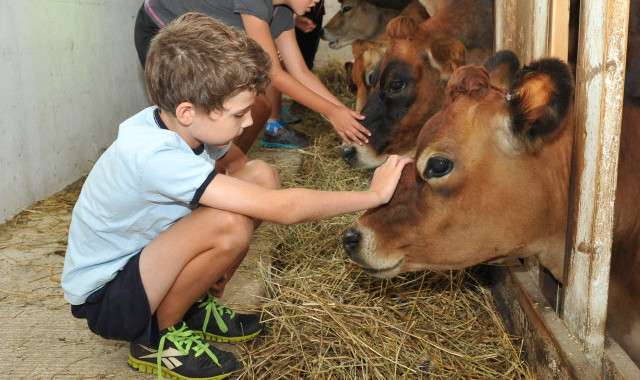This 1930s-style farm has animals, vintage equipment and interactive activities that help suburban kids to reconnect with our agricultural landscape. Step inside this amazing park-owned attraction.

Primrose Farm is the kind of place that makes learning fun. Set on more than 100 acres of open agricultural space, historic farm demonstration plots and restored buildings, Primrose Farm, 5N726 Crane Road, in St. Charles, is a 1930s-style working farm operated by the St. Charles Park District, with an eye toward preservation, education and entertainment.
“It’s one of my most favorite places in St. Charles to market because it appeals to kids and families,” says Erika Young, marketing manager of the St. Charles Park District. “It’s just fun.”
Full of animals, old farm equipment and farm workers clad in 1930s attire, Primrose Farm is a unique hands-on experience for families, summer campers and school children.
“It’s a unique site to learn about a day gone by and also learn how everything is connected,” says Laura Johns, manager of farm programs and interpretive services. “Most have a wonderful visit, and we get wonderful feedback from parents and kids, teachers and students. They learn something in the process, and they have a great time.”
The entire farm is an interactive, educational playground, but Johns says the animals are the star attraction.
“Kids are excited to see them up close and personal,” she says. “They can milk a cow, see horses in the fields, see chickens in their coops laying eggs. Their first thought is, ‘Oh my goodness, it smells like a farm.’ Then it’s, ‘Oh my goodness, look at all the animals.’”
And these are working animals that provide an essential role.
“It’s a working farm, not a petting farm, so they’re not in cages. They’re out in their normal environment on a farm,” says Johns. “Part of our job as interpreters is to introduce people to the animals, explain what role each has on a 1930s farm, what each does and how we take care of them all. And, we help people to realize that farm animals have a job to do, just like people do.”
Visitors can also reconnect with some essential farm-related arts and skills, such as milking a cow by hand, blacksmithing metal or participating in a day of chores. A visit also comes with some fun perks.
“One thing you can do at this farm that you can’t do at other farms is climb on the vintage, restored equipment,” says Young. “It’s fun to climb onto a tractor seat and pretend you’re driving out in the field. Inside the buildings, you can learn how to make butter, milk and ice cream the way they did in the 1930s.”
Fun upcoming summer events at Primrose Farm include Coffee & Cows Playgroup on the second Friday every month, when parents can sip coffee and socialize while their little farmers play and enjoy snacks and crafts; Scarecrow’s Scavenger Hunt on July 18, where visitors discover clues and solve riddles to help the Primrose scarecrow find his lost brain; and Gaming at the Primrose Pasture Midway on Aug. 15, where the pasture is converted into an old-fashioned midway full of yard games and games of skill and chance.
On Wednesdays and Saturdays all year long, visitors can sign up for times to milk a cow, gather fresh eggs from the hens, mingle with horses or learn how to care for and feed the livestock.
“We’re one of the district’s best-kept secrets, and we’re working hard to correct that,” says Johns. “But this is a place where you can learn about where our food comes from, learn how to care for animals and work on a farm and actually see the changes your work and effort can make. It’s really a great time.”




















































